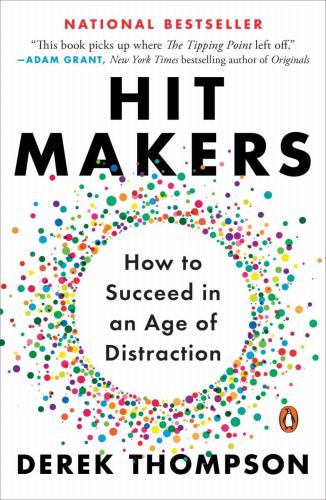
Hit Makers
How to Succeed in an Age of Distraction
کتاب های مرتبط
- اطلاعات
- نقد و بررسی
- دیدگاه کاربران
نقد و بررسی

Starred review from January 30, 2017
The alchemy of pop culture hits gets a little more scientific in this engrossing treatise on attention grabbing. Atlantic editor Thompson delves into a grab-bag of mysteries—who decided which Impressionist painters were the greatest? Why did Cheers catch on? How did Fifty Shades of Grey become a megaseller?—and finds a discernible (if not always replicable) formula. Part of the equation, he contends, is the brain’s balancing of neophobia with neophilia: humans like to see familiar, comforting patterns emerge from novel (but not too novel) situations that pique our interest in media as different as screenplays and melodies. (Lab mice are captivated by the verse-verse-chorus-verse-chorus-bridge structure of Top 40 tunes.) The other factors he fingers are sheer exposure—Seinfeld languished in the ratings cellar until it was rescheduled right after the hugely popular Cheers and finally found a viewership—and our lemming-like tendency to like whatever is already popular. Thompson gives readers a blithe, entertaining tour of the cognitive and social psychology behind our preferences, bouncing from Joseph Campbell’s doctrine of story archetypes to chaos theory, and frames it in a savvy analysis of how media technology (such as the laugh track and the like button) continually remakes tastes. This is a fun, thought-provoking take on the strange turns of cultural fortune.

December 15, 2016
How does a nice idea become an earworm, or a fashion trend, or--shudder--a meme? Atlantic senior editor Thompson ventures a few well-considered answers. We live in a world of expectations and conventions, though you might not know it. Take, say, a nice chick flick, a winning instance of which will have one or more of three types of women, "doe-eyed lover, harping mothers, and Meryl Streep." A romantic comedy, observes Thompson, breaks into three acts: two people thrash toward coupledom, come together, and face some challenge that they overcome to go back to coupledom once more. If the woman sleeps with someone else during the period of challenge, then all bets are off; barring that, norms observed, the story will move along to a more or less satisfactory conclusion. Sometimes a true hit arises that does more than ape convention, and here, in discerning how the outliers become mainstream, is where Thompson's book finds its greatest merit: George Lucas didn't quite have precedent for Star Wars, but he borrowed enough of the familiar that the films were "fathoms deep with allusions to the most common storytelling themes of the early twentieth century and the many millennia before." We like our novelty to be familiar but not too familiar. In a nice turn, the author writes, "we are born average and die unique," and just so, a hit will promise new turf without being wholly strange. And in every industry, the author notes, there are those who wish to become "toadish rejects metamorphosing into princely hits." There's not much thesis or hard science here, but there's plenty of anecdotally rich exploration in the odd corners of the sociology of communication, business history, and psychology, all to entertaining and instructive ends. Good reading for anyone who aspires to understand the machinery of pop culture--and perhaps even craft a hit of his or her own.
COPYRIGHT(2016) Kirkus Reviews, ALL RIGHTS RESERVED.

December 1, 2016
It's a question to which we'd all like to know the answer: Why do some things become popular while others sink out of sight? This book by Atlantic editor Thomas might not give an easy answer, but it does offer a thoroughly entertaining look at the potential whys of the hits and misses of popular culture, using illustrative examples that range from vampire myths and impressionist art to Star Wars and Adele's song "Hello." Popularity, he finds, relies on a perfect cocktail that includes the right amounts of such things as exposure, familiarity and difference, timing, and the impossible-to-predict factors of luck and coincidence--and while Thomas keeps a light tone throughout, he doesn't shy away from how the ingredients that make up cultural phenomena can lead to complacency in audiences and stagnation in industries. VERDICT While this book's mix of studied theory and anecdotal observation sometimes balances uneasily, it should provide some potential direction for those chasing that elusive next hit, as well as food for thought for anyone who has every pondered the mystery of why we like what we like.--Kathleen McCallister, Tulane Univ., New Orleans
Copyright 2016 Library Journal, LLC Used with permission.

























دیدگاه کاربران